US Society 77
Silencing the Study of Race and Equity

In the U.S., legislation is being passed to silence analyses on race and equity
The same historical thread: slavery-Tulsa massacre-George Floyd and is intended to hide the facts to cover up scars and, above all, wounds still open and bleeding in the polarized U.S. society.
Author:

Translated and edited by Walter Lippmann for CubaNews.
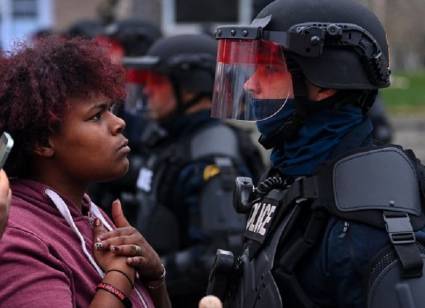
Confronting America’s systemic racism Author: Joshua Lott Posted: 05/29/2021 | 10:49 pm
Is America a racist society? Yes. Absolutely and categorically so. Facts abound to exemplify the assertion. A review of some of the incidents of more immediate times reaffirms it.
However, it is not only the acts of violence, of police brutality, especially against Blacks and Latinos, nor the rise of extreme right-wing, xenophobic and fascistic groups and organizations, that show this visible trace. Neither do the economic and educational inequalities that undermine development opportunities.
In the first days of May, the governor of the state of Idaho, Republican Bradley Jay Little, signed a bill whose purpose is supposedly not controversial: to prohibit public schools and colleges from teaching that “any sex, race, ethnicity, religion, color or national origin is inherently superior or inferior”.
It might seem positive; however, this sidesteps, indeed, eradicates, conversations about race and equity, as if they have no relevance in a society where they remain one of the biggest and most divisive problems, rooted in a historical development that had as its roots the near annihilation and dispossession of native peoples and the enslavement of men and women forcibly brought from faraway Africa.
Idaho is not unique in the trend, as a dozen states, including Iowa, Louisiana, Missouri, New Hampshire, Oklahoma, Rhode Island and West Virginia, have also introduced bills that would prohibit schools from teaching “divisive,” “racist” or “sexist” concepts.
According to a paper published by USA Today, such legislation attacks “critical race theory,” a movement of scholars and civil rights activists, which questions and critically examines how the legacy of slavery (in August 1619 the first cargo of enslaved Africans arrived on the shores of present-day U.S. territory) and systemic racism still affects American society today and are everyday experiences for people of African descent.
Thus, this legislative pattern – especially in Southern and Republican-dominated states – is seen as a backlash against teaching anti-racist lessons in schools, a barrier to learning true and hidden histories in order to entrench the racism against African descendants in the U.S. society.
The pattern is seen as a backlash against the teaching of anti-racist lessons in schools, a barrier to the learning of true and hidden histories to enthrone the socio-economic dominance of white elites, who also cover up class-based profiteering, whatever the skin color of the exploited.
Two key events
These final days of May mark two dates a century apart, the first anniversary of the murder of George Floyd in Minneapolis, when the relentless knee of policeman Dereck Chauvin squeezed his neck for more than eight minutes and prevented him from breathing. It was a crime that shook America and continues to shake it, and outraged the world. Then there is the centennial of a massacre of which very few in the northern nation are aware: the Tulsa massacre.
In Tulsa, Oklahoma, dozens of Black citizens were murdered -some estimates reach more than 300 victims of the racist barbarism of white mobs, joined by the police and the National Guard-, between the night of May 31 and June 1, 1921, in the Greenwood area, which was known as the Black Wall Street, due to the economic prosperity and intellectual development achieved by its inhabitants, and which was reduced to ruins and ashes in the fires.
Baptist minister and civil rights activist Jesse Jackson wrote in the Chicago Sun-Times: “Few even know about the massacre. It has not even been taught in Tulsa public schools until this year. Though a hundred years old, the massacre raises questions of justice and decency that
of justice and decency that America cannot avoid.”
Yet a significant part in size and power of the United States avoids it and does its best to sidestep it.
The detractors of critical race theory, the conservative elements that deny the existence of systemic racism in America, hoist its eradication and not only try to “discredit” it by calling it “Marxist”, above all they impute it to be a plan to “teach children to hate their country”, therefore, they are a threat to American society and the nation.
The Trump administration opposed the teaching of that history in public schools, asserting that it was “divisive and un-American propaganda.” Trump said, “Students in our universities are inundated with critical race theory. This is a Marxist doctrine that holds that America is an evil, racist nation, that even young children are complicit in oppression, and that our entire society must be radically transformed.”
Another reality
A recent study by Reflective Democracy, a group working to build a democracy in America that works for everyone “because it reflects who we are and how we live in the 21st century,” found that white men hold 62 percent of all elected offices despite being only 30 percent of the nation’s population, exercising minority rule over 42 state legislatures, the House of Representatives, the Senate and state offices from coast to coast.
The analysis added that women hold only 31 percent of the offices despite being 51 percent of the population and “people of color” hold only 13 percent despite constituting 40 percent of the population. It also recalled that 43 states in the Union are considering or have already passed laws that would allow them to apply voter suppression, which targets precisely those vulnerable segments – Blacks, Latinos, native Americans and women.
Some analysts recall that this wave against critical race theory only “crystallized” with Trump, but was awakened when Barack Obama came to the White House, which “was shocking and traumatic for people who had always imagined the United States as a white nation,” according to Adrienne Dixson, a professor at the University of Illinois and author of the book Critical Race Theory in Education.
On both sides, the debate has grown over the past year with the nationwide, ethnically diverse, age-group-wide activism of Black Lives Matter which burst onto the social scene of the national conservative organization Parents Defending Education, whose purpose is to confront what they consider “divisive and polarizing ideas in the classroom,” as Critical Race Theory sees it.
On their website Parents Defending Education released a study in which they claim that 70 percent of respondents said it is not important for schools to “teach students that their race is the most important thing about them.” that 74 percent opposed teaching students that whites are inherently privileged and that Blacks and other people of color are inherently oppressed. They also say that 69 percent opposed teaching in schools that America was founded on racism and is structurally racist. Likewise, they say and that 80 percent oppose the use of classrooms to promote student political activism.
Is American society polarized? Undoubtedly, and in my opinion, this is an extremely dangerous element, a boiling cauldron with no safety valve.
FBI and Assassination of Malcolm X

Malcolm X’s Family Shows Letter Implicating FBI in His Assassination
February 21, 2021
Translated and edited by Walter Lippmann for CubaNews.
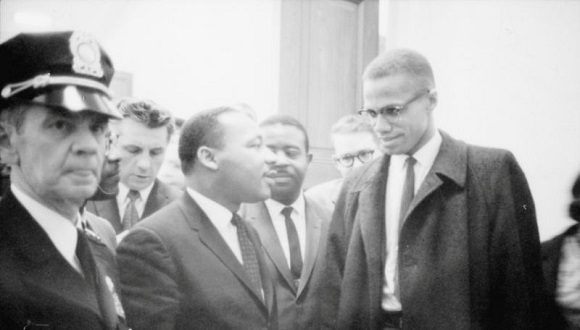
Martin Luther King Jr. and Malcolm X prepare for a press conference at an unknown location. Photo: File.
The family of Malcolm X released a letter written by a deceased officer claiming that the New York Police Department and the FBI were involved in the assassination of the famed African-American activist.
Malcolm X was an influential speaker who rose to prominence as one of the prominent voices of Nation of Islam, an African-American Muslim group that supported black racial separatism. He spent more than a decade with the group before distancing himself and finally cutting ties in 1964.
Shortly thereafter, he moderated some of his initial comments on the benefits of racial separation.
He was assassinated in New York’s Audubon Ballroom as he prepared to deliver a speech. Three members of the Nation of Islam were convicted of shooting him to death.
The letter released at a press conference Saturday was attributed to former undercover NYPD officer Raymond Wood. His cousin Reggie Wood accompanied one of Malcolm X’s daughters at a press conference at the site where the Audubon Ballroom once stood to present the document.
Raymond Wood’s letter said he had been pressured by his NYPD supervisors to manipulate two members of Malcolm X’s security detail into committing crimes that resulted in their arrest just days before the fatal shooting.
Those arrests prevented the two men from taking over guarding the entrance to the event hall and were part of the conspiracy between the NYPD and FBI to assassinate Malcolm X, according to the letter.
“At the direction of my bosses, I was told to encourage leaders and members of civil rights groups to commit crimes,” Wood’s letter said.
Some historians and scholars have argued that the wrong men were convicted. Manhattan District Attorney Cy Vance said last year that he would review the convictions in the case.
After Saturday’s press conference, Vance’s office issued a statement saying that “the review of this matter is active and ongoing.”
The NYPD said in a separate statement that it “has provided all available records relevant to this case to the district attorney” and “remains committed to assisting with that review in any way.” The FBI declined to comment on the matter.
Malcolm X’s daughter, Ilyasah Shabazz, said she had always lived with uncertainty about the circumstances of her father’s death.
“Any evidence that provides further insight into the truth behind that terrible tragedy should be thoroughly investigated,” she told the news conference.
(With information from Reuters)
Why No Socialism (for now) in the US?

Why there will be no socialism (for now) in the United States

By Dr. Salvador Capote
Translated and edited by Walter Lippmann for CubaNews.
Please see the translator’s explanation below. Thanks.
The incoherence within the two major parties of the United States has never been greater than in these times. Roughly speaking, the Republican Party is divided between Trumpists, with their far-right extremism, and conservatives who follow the traditions of the “Grand Old Party” (GOP), while in the Democratic Party a left-wing has been strengthened whose most conspicuous figure is its independent ally, Senator Bernie Sanders. Joe Biden represents the mainstream, while Bernie Sanders represents the left of the political spectrum.
=========================
Translator’s comment: The author is someone I’ve never met. He is a Cuban-American living in Bentonville, Arkansas, according to his Facebook profile. He posts short and pithy interpretive essays on Facebook and Radio Miami TV. He has lived in the United States for a very long time (but just how long I cannot say because I do not know), but he always has something sensible and thought-provoking to say. Those who are wondering, after all the years of social support cutbacks and racist repression, why there is STILL no broad-based left-wing political opposition here in the United States, will, I think, find a lot here in Dr. Capote’s explanation to reflect upon.
On the life and legacy of MLK Jr.

Martin Luther King Jr., comments on his life and legacy
Author: Víctor Fowler
lajiribilla@cubarte.cult.cuJanuary 01 to January 25, 2021
Translated and edited by Walter Lippmann for CubaNews.
On December 1, 1955, during a public bus ride in Montgomery City, Alabama, a 42-year-old black seamstress named Rosa Parks refused to give a white man the seat in which she was sitting. The codes of segregated behavior at the time included that Black people (in the southern states) paid their fare by boarding at the front door, where the driver was located, alighted to re-enter the bus now at the rear door, and only then sought accommodation in the back seats. Black people were not even allowed to walk through the aisle of the bus between white passengers to the back of the bus.
If they acted otherwise, for example, by remaining seated (which is what Parks did), the driver – who, in all likelihood, would offend the offender – was to call the police to take them to the station and, later, to try and punish the Black man or woman foolish enough to violate the rules. A little more than ten years earlier, Parks herself had had an altercation when, after paying, she refused to enter through the back door; on that occasion, rather than be arrested, Parks chose to leave the bus.
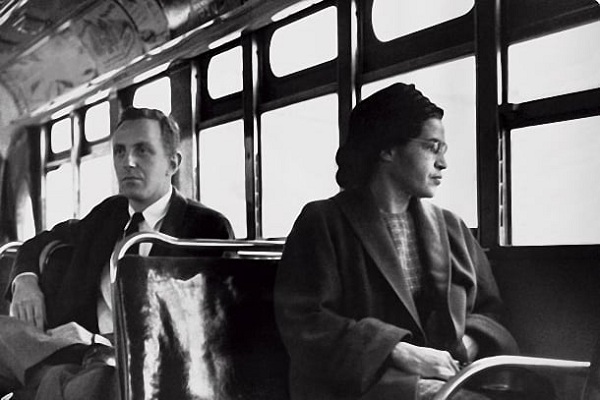
“Segregation in theaters, restaurants, hotels and buses was a constant irritation in daily life and an insulting nuisance.” Photos: Internet
The above episode is known as one of the main moments, the detonator, of a protest of leaders and, in general, Black demonstrators who – opposed to this segregationist practice – maintained a boycott against the company that extended, heroically, throughout a year and that would draw the attention of the mass media of the entire country to the violence and cruelty of racial discrimination in the South of the American nation. As stated from the very beginning of the volume Civil Rights in America. Racial desegregation of public accommodations. A National Historic Landmarks theme study:
Physical separation of the races in public accommodations was an uncomfortable and degrading practice for those who were denied equal access. Segregation in theaters, restaurants, hotels and buses was a constant irritation in daily life and an insulting nuisance. This resulted in direct confrontations between racial minorities who demanded their right to pay for goods and services in the marketplace, and white business owners who demanded the right to only serve whom they chose.[i] The segregation of theaters, restaurants, hotels, and buses was a constant irritant in daily life and an insulting nuisance.
The roots of the problem extend to the beginning of the 19th century when the northern states of what would become the United States of America virtually abolished slavery thanks to a variety of “constitutional, judicial or legislative” actions (p. 6). At the same time, in the South, the practices of separation between races intensified.
Along with this, the anxiety of contact meant that in the most racist nuclei of the northern elites, efforts to extend spaces differentiated according to skin color also multiplied. An example of this is the introduction of cars for Black people on trains and the numerous cases of protest and refusal to travel in them (even the great black abolitionist Frederick Douglass was removed from his seat on one occasion for refusing to change cars).
An 1857 court case, Scott v. Sandford (where a slave, Dred Scott, tried to prove that – because he had resided in non-slave states – he should be considered a free man), was to have enormous consequences for the struggles that were to take place a hundred years later and that we know today as the Civil Rights Movement. In the Dred Scott case, which Scott lost, the Supreme Court ruled not only that the plaintiff was not a citizen, but that “Congress had no authority to prohibit slavery in the territories”.
In other words, decisions about slavery (and others in this area involving customs) were left to the states and local governments. Another important decision was Hall v. DeCuir (1877) where it was decided that “the laws of a state are not applicable to interstate ship voyages and that only Congress can regulate interstate commerce”. Finally, Plessy v. Ferguson (1896) opened the door for the extension of “segregation of the races, provided the separate facilities were of equal quality.” [ii]
Although protests throughout the century led seven southern states to eliminate laws that favored segregation in the public space, legal decisions such as those mentioned above made possible a reality where supply found its most evident application in Black individuals of high economic capacity .For the same price as their white counterparts, Blacks could travel in a sophisticated train carriage, while in the lower economic strata the difference was perfectly visible in the quality of supply and in the treatment received.
II
Parks’ arrest was followed by a mobilization on her behalf whose movers and shakers included Edgar Daniel (E. D.) Nixon, leader of the Brotherhood of Sleeping Car Porters (with whom Parks had worked in the NAACP); Clifford Durr, a white Montgomery lawyer and strong advocate of interracial democracy with his wife Virginia; Jo Ann Gibson, an English professor at Alabama State College; and – among the clergy who offered support – a young pastor, just 26 years old, named Martin Luther King Jr. The success of the boycott, planned to last one day, was such that the organizers decided to extend it, and so it ended up spanning an entire year; along the way, on January 30, 1956, a bomb exploded in King’s house and on February 21 -along with almost 90 protest leaders- he was arrested and charged with having organized a boycott considered illegal. On November 13, the Supreme Court ruled that the Fourteenth Amendment prohibited racial segregation in interstate as well as intrastate travel, and so, on December 21, 1956, Reverend King “along with several black and white companions boarded a bus for a historic unsegregated ride” (p. 46).
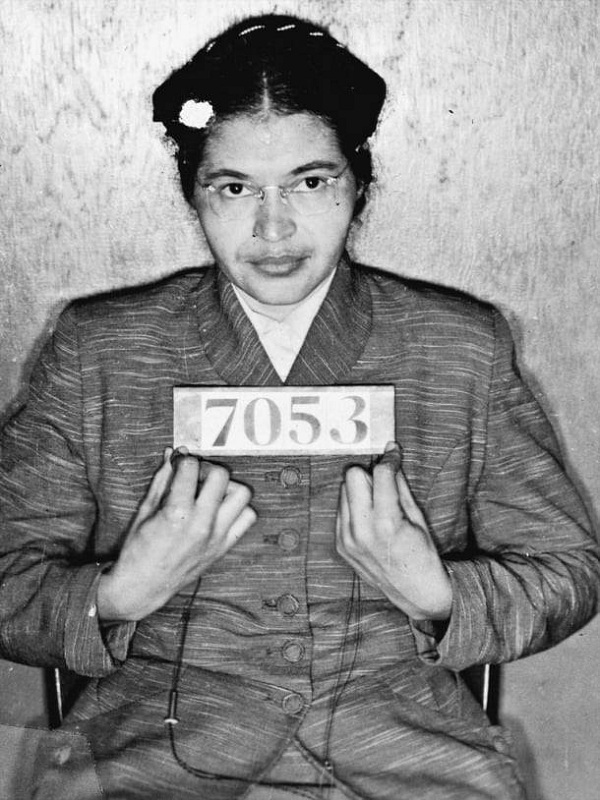
“Parks’ arrest was followed by a mobilization in her favor.”
From this point on, the life of Martin Luther King Jr. began to become more risky, complex and to grow into a legend. The son and grandson of Baptist pastors, a pastor himself, MLK developed his political, social, religious and cultural action in the brief period from 1955 to April 4, 1968, the date on which he died in Memphis, assassinated by James Earl Ray, a racist shooter. In this brief period, he became a leading figure in the Montgomery bus boycott (1955-1956); he helped found and was the first president (1957) of the Southern Christian Leadership Conference (SCLS); led the March on Washington for Jobs and Freedom in August 1963, where he delivered his famous I Have a Dream speech, recognized as one of the most important pieces of oratory delivered in the country; was awarded the Nobel Peace Prize in 1964 and was a leading figure in securing passage of the Civil Rights Act of 1964 and the Voting Rights Act of 1965. In addition, he was the central figure in two of the greatest battles for civil rights: those that took place in the cities of Birmingham and Selma, both in the state of Alabama, in 1963.
III
In the first of these, on April 13, 1963, King was arrested and during the three days he was behind bars he wrote his well-known Letter from Birmingham Jail in which he said, “Injustice anywhere is a threat to justice everywhere. We are caught in an inescapable tissue of mutuality, bound together in a simple fabric of destiny. Anything that affects one directly affects all indirectly.” In that same document, MLK would explain the essence of nonviolence (the Gandhian-inspired mode of protest that he breathed into the Civil Rights Movement) as follows:
Why direct action, sit-ins, marches and the like? Isn’t negotiation a better way? You are exactly right in your call for negotiation. Indeed, that is the purpose of direct action. Nonviolent direct action seeks to create such a crisis and establish such creative tension that a community that has consistently refused to negotiate is forced to confront the problem. (…) I have worked and preached vigorously against violent tension, but there is a kind of constructive nonviolent tension that is necessary for growth.[iii] I have worked and preached vigorously against violent tension, but there is a kind of constructive nonviolent tension that is necessary for growth.[iii]
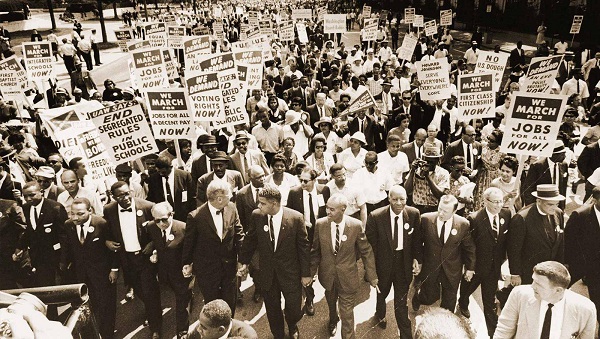
“There is a kind of constructive nonviolent tension that is necessary for growth.”
The condition of nonviolence could only find its foundation in the love that cares for the suffering other and that, as part of God’s created works, even embraces the other who oppresses. Because of this, King’s nonviolence opposes both the part of the Black community that accommodates segregation (be it the lower strata or the academic sectors) and those who preach hatred and separation between the races (which, in context, pointed to the Black nationalists of Elijah Muhammad).
IV
Martin Luther King’s social thought reached its greatest radicalism when, in an endeavor that would bring him multiple misunderstandings (even among leaders of the anti-racist struggles) as well as numerous new enemies (both among whites and Blacks), he became one of the most prominent intellectuals and political figures who publicly opposed the Vietnam War. The statement that gained the greatest resonance in this regard was the speech Beyond Vietnam: The Time to Break the Silence, delivered on April 4, 1967, at Riverside Church before an audience of about 300 people, exactly one year before his death, whose first sentence was: “Tonight I have come to this magnificent house of worship because my conscience leaves me no other choice”, and where he singled out the United States as “the greatest purveyor of violence in the world today”. The finesse of the socio-political analysis that MLK was able to develop shines through in excerpts such as the following:
Repeatedly we have been confronted with the cruel irony of watching black and white youths on television screens as they kill and die together for a nation that has been unable to seat them together in the same schools. We have seen them in brutal solidarity, burning shacks in a poor village, but we understand that they would never live together on the same block in Detroit. I cannot remain silent in the face of this cruel manipulation of the poor.[iv] Increasingly, by choice or by choice alone, the poor are being manipulated.
Increasingly, by choice or by accident, this is the role our nation has played – the role of those who make peaceful revolutions impossible by refusing to give up the privileges and pleasures that come from the immense benefits of investments across the sea.
I am convinced that, if we are to get on the right side of the world revolution, we need, as a nation, to undergo a radical revolution of values. We need to quickly begin the transformation from a “things-oriented” society to a “people-oriented” society. When property rights and the profit motive are more important than the person, it is impossible to conquer the gigantic trio of racism, materialism and militarism.[v] (Idem)
V
The other enormous cause to which MLK devoted a great deal of energy was the struggle of American workers for better wages, health care, education for their children, and decent housing. The satisfaction of such demands had to derive, in Luther King’s thinking, from the action of workers integrated into a powerful, organized, highly conscious and nonviolent labor movement; the speech delivered to the Illinois state labor union meeting on October 7, 1965, in Springfield is an illustration of that idea as the following quote shows:
The labor movement was the main force transforming misery and despair into hope and progress. As a result of hard-fought battles, economic and social reforms gave birth to unemployment insurance, age pensions, government assistance for the indigent, and, above all, new standards of living that meant mere survival, if not tolerable living. The captains of industry did not lead this transformation; they held out until they were overrun.[vi]
For Cornel West, editor of the volume The Radical King, MLK’s growing engagement with progressive guild leaders “is integral to his calling”; according to the well-known scholar, poverty was for King not only “a barbaric form of tyranny to be banished from the Earth,” but that “the greatness of nations or civilizations is measured not by military might, architectural prowess, or the number of multimillionaire citizens; the greatness of who or what we rather consist in how we treat the least of these: the weak, the vulnerable, the orphan, the widow, the widow, the stranger, the poor, the marginal, and the prisoner (West, 2014).
VI
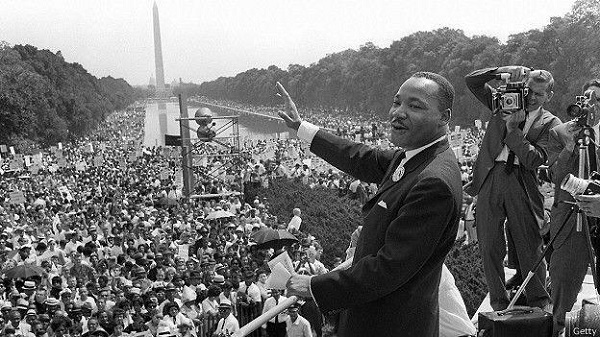
“The other enormous cause to which MLK devoted a great deal of energy was the struggle of American workers for better wages, health care, education for children, and decent housing.”
MLK’s last (and unfinished) great battle was the so-called “Poor People’s March” -which sought to repeat the massive demonstration of people in front of the Capitol in Washington, which in 1963 had attracted a quarter of a million people-, but now to demand a fairer redistribution of wealth in the country. In political terms, the most outstanding feature of this new mobilization was that it was intended to convene and represent a multiracial sector which, in addition to Black Americans, was intended to include Native Americans, Mexicans, Puerto Ricans and poor white Americans. Thus, in a speech delivered in New York on March 10, 1968, he was able to say:
Now, I said poor people, too, and by that I mean all poor people. When we go to Washington we are going to have black people with us because black people are poor, but we are also going to have Puerto Ricans because Puerto Ricans are poor in the United States of America. We are going to have Mexican-Americans because they are mistreated. We are going to have Native Americans because they are mistreated. And for those who don’t let their prejudices lead them to blindly support their oppressors, along with us in Washington we’re going to have Appalachian whites (West, 2014).
VII
MLK’s last public speech was the sermon he delivered in Memphis the night before his assassination. Known as I Have Been to the Mountaintop, this beautiful oratorical piece is inspired by the biblical story of Moses (who, after the Exodus, leads the people of Israel to the very Holy Land, although he dies without entering it) to establish a chilling parallel -in light of what was to happen the next day- between the biblical prophet and Martin Luther King himself. Following several investigations and testimonies about those last weeks, the amount of pitfalls, persecution, threats and misunderstanding around MLK damaged his spirit and health, to the point of causing depression and lack of sleep, among other ailments. Some testimonies even speak of the fact that, after years of threat, MLK began to feel, foresee or expect to meet an early death. The speech begins with a strange proposition that the speaker receives from the Almighty himself: to choose the era in which he prefers to live and this, after a long journey through time, turns out to be the one in which we find ourselves. At the end, after mentioning the possible threats to his life, MLK pronounced the following closing paragraph:
We’re going to have some tough days ahead, but I’m not interested in that right now. Because I’ve been to the top of the mountain. And I don’t worry about it. Like anyone else, I’d like to live a long life. Longevity has its place. But I’m not worried about it now. I just want to fulfill God’s wishes and He has allowed me to climb the mountain. And I’ve looked around. And I have seen the Promised Land. I may not go in there with you, but I want you to know tonight that we, as a people, will get to the Promised Land. And I am happy, tonight. I am not worried about anything. I fear no man. My eyes have seen the glory of the coming of the Lord (West, 2014).
VIII
During the funeral of Martin Luther King Jr., following the wishes of his widow, Coretta, excerpts from the sermon entitled The major drum, King delivered on February 4, 1968, at his Ebenezer Church in Atlanta, Georgia, were heard. May these words serve as a farewell:
If any of you are around when it’s my turn to find my day, I don’t want a long funeral. And if you have someone to say the eulogy, tell them not to talk too much. (…)
Tell him not to mention that I have a Nobel Peace Prize, for that is not important.
Tell him not to mention that I have been awarded three or four hundred other recognitions, because this is not important.
Tell them not to mention where I went to school.
But I would like someone to mention that day that Martin Luther King Jr. tried to give his life in service to others.
I would like someone to say that day that Martin Luther King Jr. tried to love someone.
I want you to say that I tried to take the right stand on the issue of war. I want you to be able to say that day that I tried to feed the hungry.
And I want you to be able to say that in my life I tried to clothe the naked.
I want you to be able to say that day that I tried to visit those who were in prison.
I want you to say that I tried to love and serve humanity.
Yes, say – if you wish – that I was a drum major; say that I was a drum major for justice.
Say I was a drum major for peace.
I was a drum major for honesty and all the other superficial things won’t matter.
I had no money to leave behind me.
I didn’t have the fine and luxurious things of life to leave behind me.
But I do want to leave a life of commitment and this is all I want to say.
If I can help someone as I pass.
If I can celebrate someone with a word or song.
If I can show someone that their journey is wrong,
then my life will not have been in vain.
If I can do my duty as a Christian,
If I can bring salvation to this world once built,
If I can spread the message as the master taught,
then my life will not have been in vain.
Yes, Jesus, I want to be at your right hand and at your left, But not for any selfish reason.
I want to be on your right and on your left, not in terms of some political kingdom or ambition, but I want to be right there in love and justice, in truth and commitment to others, so that it will make this old world a new world. (Idem)
CITATIONS:
[i] Cianci Salvatore, Susan. Civil Rights in America. Racial desegregation of public accommodations. A National Historic Landmarks theme study. Washington, D. C.: National Park Service, U.S. Department of the Interior, 2009.
[ii] Schultz, David (ed.) Encyclopedia of the Supreme Court. New York: Facts of File, 2005.
[iii] West, Cornel (ed.) The radical King. Boston: Beacon Press, 2014.
[iv] Idem.
[v] Idem.
[vi] King, Jr., Martin Luther. All labor has dignity. Boston: Beacon Press, 2011.
Polarization and a repressive environment

United States:
Polarization and a repressive environment
By Fernando M. García Bielsa
December 23rd, 2020
Translated and edited by Walter Lippmann for CubaNews.
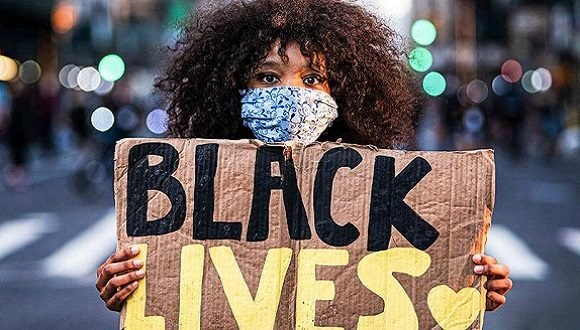
The latest incidents of police brutality and racist killings in many U.S. cities are not a recent phenomenon. They are long-standing events, stemming from the days of slavery and, as now, developing alongside the violence of paramilitary and white supremacist groups.
The warlike projection of the country and its having reached the point of being permanently involved in a series of wars in various confines, has permeated the psyche of thousands of people and is reflected in a growing militarization at the domestic level. In addition to police brutality, it is clearly expressed in the proliferation of violent groups, as well as in government agencies such as the prison system, the militarization of the border with Mexico, and violence against immigrants.
In addition to the violent and racist tradition with which the U.S. nation was formed and the impact of imperial militarism, there are also the social fractures, polarization, and growing inequalities that this society has shown in recent decades. There are tens and tens of millions of people inserted in a vicious circle of residential segregation in unsafe neighborhoods lacking basic services.
Let’s look at some background
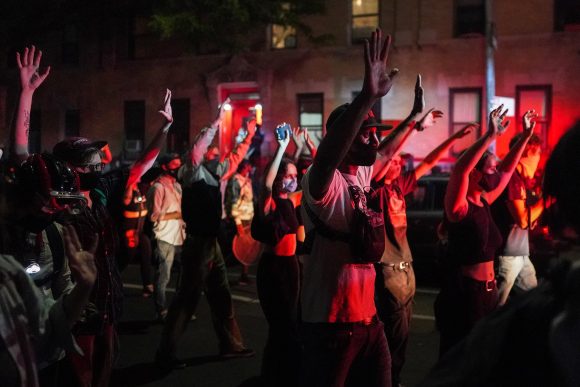
Protests in New York against racism. Photo: The New York Times/Archive
The question of race and racism against Blacks has been a major factor in shaping American culture and policy from colonial times and the formation of the republic to the present. Much of national politics revolves around them. The historical and current location of African Americans is – in many ways – central to the country’s problems.
In turn, Black political movements and activism have historically been at the forefront of struggles for progressive change in the United States, a vast and diverse country where class and other movements have been co-opted or fragmented. This is influenced by historical reasons, immense institutional obstacles, as well as the dimensions of the country, the tensions arising from the multi-ethnic character of its population, and the growing weakness of the labor movement.
In the late 1960s and 1970s, so-called “communities of color” began to understand that society, as it existed, would never address their needs as they were perceived and felt. It was in this period that exploring their cultural heritage and building their own institutions became their greatest strength. The Black Power slogan had electrified Black communities across the country.
A dramatic transformation in the self-image of Black people began, in the context of one of the most effective social movements to date in the country, of racial pride, collective consciousness and community solidarity, with enormous repercussions in society as a whole.
After the impact of the great struggles and mobilizations of the Black civil rights movement, it became evident to sectors of power that the strength of such movements was being enhanced given the serious social problems in those communities. For this reason, since the 1960s, a whole series of government programs and assistance projects for the “development” of marginal areas and Black communities had been spreading.
Among the results of these programs was the strengthening of reformist groups and economic interests, as well as contributing in the long term to the formation of a whole layer of African American and Latino professionals and politicians with possibilities of access, public presence, and supposed representation of the interests of so-called ethnic minorities.
The Black bourgeoisie, including that which developed during the Obama administration, has continued to make false promises of inclusion. Except in the recent context in reaction to the wave of killings and police violence, organized political activism by African Americans has reached this stage after a long period of ebb.
Black groups have remained atomized, uncoordinated, focused on immediate economic and social concerns, and their energies have become diffuse, marked by the needs and life emergencies of their social bases, internal divisions, and the social polarization in their communities. External manipulations of all kinds do the rest.
The appearance of greater political influence by the Black population given the access of a few of their own to positions of some visibility has been misleading. Despite some advances in participation and representation, Blacks continue to fare worse than whites in having their political preferences and interests legislated.
The increase in class diversity that has taken place within these ‘communities’ and the nefarious role played by the Democratic Party in presenting itself as a champion of the underprivileged when in fact it is subject to the interests of the country’s financial elite, were felt.
A polarized and contentious society
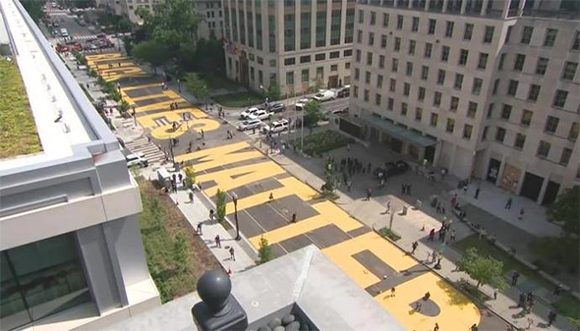
Black Lives Matter mural on a street in Washington Photo: CNN.
The United States shows a growing number of very deep social divisions. Racism and the dangerous ideology of white supremacy is a serious obstacle to social cohesion, and is sometimes conducive to and at the root of serious outbreaks of violence. Demographic trends, some warn, suggest that the nation will not be sustainable in the long term unless marked inequalities between populations of diverse ethnic backgrounds are corrected.
Analyst Tim Wise said (on the Truthout website, March 2, 2012) that, in 25 or 30 years when non-whites will be half the population and the majority in several states, it will not be sustainable for the country to maintain that population as it is now. Blacks today are three times more likely to be in poverty than whites, twice as likely to be unemployed, with several times less assets and with an income less than the other half of the citizenry, and with nine years less life expectancy.
Behind that reality, repressive conceptions prevail. These are not only fed by overflowing militaristic mentalities or fears of ungovernability, but they are backed up by calculations of profit generation. These are derived from the so-called wars on drugs, mass incarceration in private prisons, outsourcing to private “security” agencies, and institutionalized repression against immigrants and marginalized populations.
The focus of repressive state activity is directed against Black groups and progressive organizations, which has led to the violation of civil liberties, the criminalization of social movements, increased surveillance and infiltration of Black, Latino and poor Muslim institutions and communities, including the deployment of undercover police, informants and intimidation in homes and public spaces.
–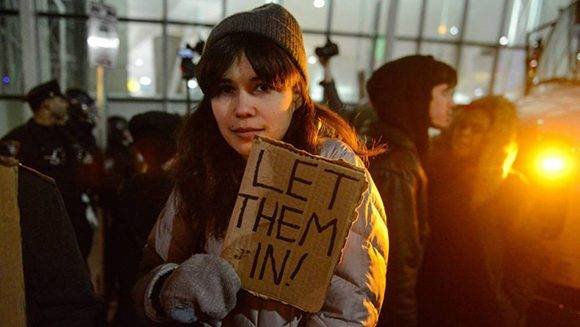
A woman protests in New York against the ban on Muslims in Trump. Photo: Stephanie Keith/ AFP.
Muslim communities in the country face an environment of growing intolerance and hostility since the September 11, 2001 attacks. State and local police forces gather information and spy on law-abiding Muslim citizens. They become targets of violence as an extension of racism and xenophobia to our day, virtually demanding submission and near abandonment of their cultural and identity expressions.
So far, anger and despair have replaced the organizational strength and momentum of the civil rights era.
Trapped in almost immovable racist structures
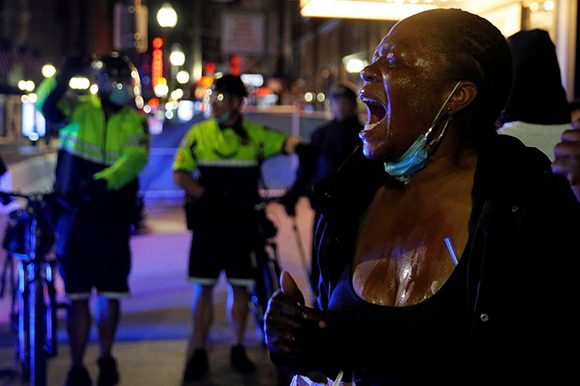
A woman affected by the tear gas launch during a protest in Boston in June. Within six nights, the agitation spread to every major city in the country and became a general protest against systemic racism in the United States. Photo: Brian Snyder/Reuters.
U.S. society is deeply fractured politically and across class, regional, economic, ethnic, religious, and cultural interests. Racial issues intersect with class differences and class oppression, and are often instrumentalized for political purposes. Levels of violence resurface; disparities are enormous. There are pockets of the population where people live in constant paranoia.
Even after the great rebellions against racism and the successes of the civil rights movement in the middle of the last century, including the partial dismantling of many of the legal structures that supported segregation, racial inequality remains a palpable fact. The racial chasm is widening and has not been altered by changes in government.
Racial prejudice in the United States has a strong negative impact on the lives of African Americans. It expresses itself in forms of discrimination in all areas and conditions of existence: segments of the population caught in a vicious circle of residential segregation, inferior opportunities for education or health services, marginality, increasing rates of incarceration, and discrimination in employment. Black workers receive 22% less than white workers in their wages, with the same levels of education and experience. The average income of African American households is just over half that of white households.
In most cities and urban areas of the country there are separate areas where the Black population resides,. This reflect the historical racial segregation that shaped the country and the policies created in the past to keep Black people out of certain neighborhoods. Many of these slums have high levels of poverty and face an intense and unwanted police presence.
In such an atmosphere and because of such deep-rooted prejudices, any activity, no matter how innocent, in which a Black man is involved generates suspicion, alarm and often danger to his life. Consider also that the rate of Black citizens in prison is five times that of white citizens. Despite being only 13% of the population they constitute 40% of all incarcerated men.
Highly peaceful neighborhoods coexist with others where violent death ravages the usually poor. Entire communities of Black, Latino, Muslim or Asian populations feel their communities are under increasing police occupation.
U.S. society has not been able to address the root causes of the outrage and anger that consume millions and are behind the recent powerful demonstrations against repression and racism. Neither politicians nor public institutions have established effective government programs to mitigate at least these gross inequalities, ultimately produced by the prevailing capitalist system.
On the other hand, what that society has done quite effectively is to divide and co-opt many of the struggles and organizing efforts that were going on in those communities.
The re-emergence of a “new Jim Crow,” that is, of a climate of brutal segregation, based on the mass imprisonment and repeated police killings of unarmed Black men, shows that the old systems of repressive control have increased in the present, always maintaining the dividing line of skin color.
In contrast, white hate groups, nationalists and racists, as well as their armed paramilitary branches, proliferate and carry out violent actions, often being overlooked or even in collusion with authorities in certain regions. Many of President Trump’s words and actions have seemed to encourage such groups.
All of this demagogic rhetoric, which has a fascist slant and is a mirror of the country’s war policies, encourages desperate sectors to organize themselves into militias to wage crusades of various kinds. It is a propitious environment when more than 300 million firearms, many of them of high caliber, are in the hands of the population, when a part of the hundreds of thousands of war veterans live with their frustrations, resentments and traumas of their war experiences.
In this context, hundreds and hundreds of right-wing armed militias throughout the country are operating, whose ideology and motivations are a combination of paranoia, fear and aggressive claims of their rights to carry firearms, receptiveness to elaborate conspiracy theories and extreme anti-government anger. Many claim that the country’s government has been subverted by conspirators and has become illegitimate, and therefore see themselves as patriotic by organizing themselves paramilitarily, confronting the authorities, and fomenting racial warfare.
An increasingly complex urban [and national] future
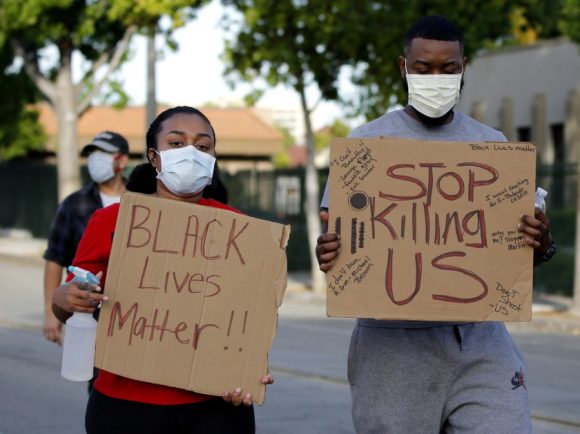
Stop killing us. Photo: Raul Roa/Daily Pilot
Many authorities, in conjunction with the media, continued to criminalize protests and progressive groups, going so far as to characterize minor actions as violent crimes and even “terrorism.
Raising alleged “security” interests, the so-called program to Counteract Violent Extremism (CVE) was begun under the Obama administration (2009-2017), that openly resembles the repression against radical groups and the COINTELPRO program of the 1960s and 1970s, and that was added to the actions deployed after the passage of the Patriot Act in October 2001 and other actions.
On the basis of sections of that law, federal agencies are able to make more and more inroads into areas of civil and personal life. The FBI, for example, can demand information such as telephone and computer records, credit and banking history, etc., without requiring court approval and without being subject to controls on the use that the feds make of such personal information.
Abuses and violations of the law often occur. Such is the case when attention is drawn to controversial sections of the Foreign Intelligence Surveillance Act of 1978, which allow for the conduct of mass spying on Americans communicating abroad. Recently the National Security Agency (NSA) has admitted to improperly collecting several hundred million phone calls from U.S. citizens.
According to William I. Robinson, a specialist on these issues, in his January 2018 article Global Police State, as war and state repression are privatized, the interests of a wide range of capitalist groups converge around a political, social, and ideological climate conducive to the generation and maintenance of social conflict.
For some time there have been signs that the government was anticipating the possible occurrence of serious civil problems and disturbances.
A video entitled “The Urban Future and its Emerging Complexity,” created by the U.S. Army to be used in the training of special forces, is revealing of the mentality and attitude in state entities regarding citizenship and the so-called “problems” that the government must be prepared to face through the use of martial law.
Already in 2008, a report from the Army Defense College stated that in the face of the possibility of a wave of widespread civilian violence within the country, the military establishment planned to “redirect its priorities under conditions of exemption to defend domestic order and the security of the people.
In its 44 pages, the report warned of the potential causes of such problems, which could include terrorist attacks, unanticipated economic collapse, loss of legal and political order, intentional domestic insurgency, health emergencies, and others. It also mentioned the possibility of a situation of widespread public outcry that would trigger dangerous situations and that would require additional powers to restore order.
In recent years, the U.S. state has radically expanded its punitive and surveillance capabilities. To limit protests, control dissent and popular opposition, as part of the well-known actions of the FBI and local police forces in previous decades, the system used administrative and legislative methods, espionage and covert infiltration, discrediting actions, massive “preventive” arrests, police attacks even against authorized peaceful protests, and so on.
The FBI’s budget for funding undercover agents, much of it within progressive organizations, rose from $1 million in 1977 to several tens of millions today.
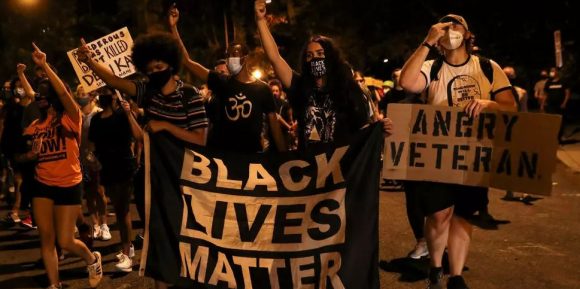
People march with signs, protesting police violence and racial equality in Washington, USA, on September 5, 2020. Photo: Leah Millis / Reuters
See also:
In the United States, Black deaths are not a flaw in the system. They are the system.
Domestic Terrorism?

Domestic Terrorism?
This is like saying “homemade terrorism,” almost always made for export, only this time the three cups of broth were in the halls of the U.S. Congress
January 18, 2021 00:01:54
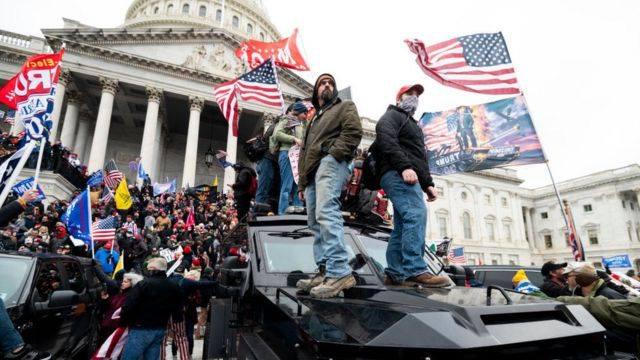
Photo: Taken from the Internet
This is what Joe Biden called the occupation, by force, of the Capitol in the United States. This is like saying “homemade terrorism,” almost always made for export, only this time the three cups of broth were in the halls of the U.S. Congress.
But this act of “domestic terrorism” had an agitator: Donald Trump, the president who reluctantly leaves the White House chair.
After that disaster, he called them intruders. The fact is that they played their part, or left the script; they no longer serve the game of lies; the change in attitude reminds us of the scene of the president throwing rolls of toilet paper at a Puerto Rican crowd after a hurricane on that neighboring island.
And it all happens in a country that extends the Cesarean finger to give or take life, issue certificates of democracy, or make spurious lists of countries that sponsor terrorism. Now they have no other honorable way out than to tear up the nomination sheet and sign up first.
However, President Trump only uncorked the bottle full of old demons: one of the flags that was carried by the “domestic terrorists” carried the symbols of 19th century slavery and racism.
José Martí, who lived in that country for 15 years, observed with concern the division and hatred. He learned of a marriage that was stoned to death because it was a white woman married to a black man. He saw children selling newspapers in the cold of New York. He saw the struggles between Democrats and Republicans and the role of money in the elections. He felt with pain the separation between rich and poor, and the imperial appetites for devouring other peoples. He did not hesitate to affirm that the United States of America was not the model to follow for the emerging Republics of Our America, since that giant already had feet of clay.
When he prepared for the Necessary War, he knew that this one is not only for Cuba and Puerto Rico, but “to save the already doubtful honor of English America”. Martí was not only a revolutionary for Cubans, he is also a revolutionary for the American people.
The images of the assault on the seat of American democracy confirm the future of José Martí’s thinking, that which opens the door to the spirit of Lincoln and closes the way to the dangers of the adventurer Cutting, the ancient face of those who now feed the supremacy of some men over others.
Many of those who attack Cuba, and tear their clothes in the name of freedom, now keep a strange silence. They turn their faces away, as if this matter were of minor importance, something very domestic that does not deserve to raise its voice, much less to fill its head with ashes.
Only this time, from the pages of Don Quixote, an old certainty jumps out: “The truth thins, but does not break, and always walks on the lie like oil on water”. This is one of the realities that floats: the shamelessness of “domestic terrorism”, made in the very house of the empire.
Related information
Assault on the Capitol: “democracy” in the U.S. again in question
Two Countries Competing in the USA
In the United States, two countries are competing
By Manuel Yepe Menéndez
January 1, 2021
Translated and edited by Walter Lippmann for CubaNews
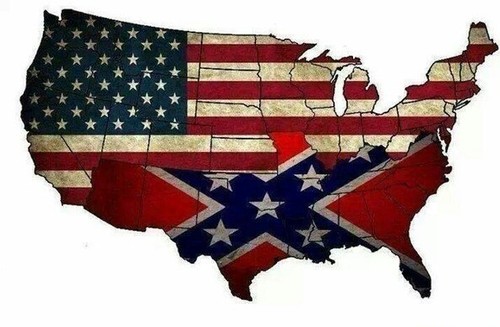
Southern map of the Confederate states.
In the middle of the 19th century, the Republican Party, representing the interests of the nascent U.S. industrial capital, won the military battle against the Southern Democratic Party, which represented and defended the slave plantation and slavery itself.
However, the southern institutions-including its religious system that justified slavery and defined whites as superior social beings-did not disappear. The defeat suffered by the South permeated southern society, which since then has seen the North as foreignizing, secularizing, and foreign: an enemy to be fought. The civil war, which for the North ended in 1865, had just begun for the South.
The assassination of Abraham Lincoln by a Southerner in that year meant the first questioning of the power of the North. This situation has continued until today.
The South, since then, has been discriminated against by the power of the North. As the family farm became extinct, replaced by agribusiness, those displaced farmers who opposed the new capitalism – which, by paying low wages to Mexicans, made it impossible for the farmers to prosper – became allies of the South.
A southern nationalism opposed to the north developed in the south. If one thinks of the United States as a single nation, this phenomenon may go unnoticed. But, in reality, they are two nations with different dynamics.
The southerners were free traders because the plantations in the south depended on cotton exports to Europe. Those in the north who industrialized were protectionists, influenced by an ideology of self-employment oriented to depending on the work of farmers in the field, with or without slaves. In the south, which extended along the east coast to Virginia and reached the gates of Washington, it dominated the plantation.
The South’s military defeat in the Civil War did not mean the defeat of the South’s institutions, nor its ideology. The North became industrialized and today depends on finance, banks and mortgages since the industries disappeared when they were sold to the Third World. The South, on the other hand, continued to be agricultural until the 1920s when large-scale oil extraction began in Texas, Louisiana and Alabama. Therefore, it was in the South where, little by little, the powerful oil power group developed.
In the south, whites were mostly poor but considered superior to slaves. There the Ku Klux Klan emerged in 1866, which soon became the terrorist organization that channeled white supremacist hate in the United States and whose function was to keep alive those practices that the new anti-slavery laws prohibited. The ban on voting for Blacks was maintained and only after a new intervention by the North with federal troops a century later were the civil rights of Blacks legally recognized.
Nationalist and conservative ideology spread in the South as part of the tradition of identifying with the past. The “founding fathers” recognized slavery and did not question it. Even the text of the Constitution, in its original version, allowed slavery.
One element that cannot be ignored is the religious aspect. The ideology of revanchism is based on the religion of Southern Baptists, for whom the South had been God’s chosen people in their struggle against the North. For them, they lost the civil war because God was testing them. The expansion of the country before and after the civil war was led by Southerners. And the same thing happened in the states bordering Canada, where a northern European Lutheran tradition joined with local racist attitudes. Many Southerners left for Alaska. The state of Utah is populated by Mormons, a racist theology with southern bases from that right-wing Arizona tradition.
Blacks and ethnic groups have been influenced by this ideology through the “prosperity gospel” that this movement has emphasized since the 19th century.
When people in North America talk, especially during election periods, about blue states and red states they are referring to two nations.
That’s why it was said that, according to the Southern view, Barack Obama embodied the interests of the North as a northerner (from Chicago), Black, and an ally of the world of finance – the three elements that the Southern right identified in the struggle against the North. On the other hand, to Donald Trump, who was defeated in 2020, was attributed the status of defender of the interests of the red states, because he had assured majority electoral support in the most industrialized states.
Death Over the Factories of Death

Death Over the Death Factories
War industries, U.S. priorities for economic reopening in the midst of the COVID-19 pandemic, as Pentagon budget continues to rise madly.
 August 10, 2020
August 10, 2020
By Juana Carrasco Martín
juana@juventudrebelde.cu
Translated and edited by Walter Lippmann for CubaNews.
It could be the agricultural implement factories, but that is not the case. They should increase protective measures for workers in the meatpacking industries, for employees in supermarkets, or for agricultural workers, but that is not their intention either.
There isn’t even an equal standard for health-care workers, and Blacks and Latinos are infected with the new coronavirus three times more than their white counterparts, according to a New York Times analysis of the records of the Centers for Disease Control and Prevention (CDC).
The study also found that minority workers were 20 percent more likely than white workers to care for suspected or confirmed Covid-positive patients. The rate rose to 30 percent specifically for Black workers. In addition, they also reported inadequate or reused protective equipment (PPE) at a rate 50 percent higher than that reported by white workers. For Latinos, the rate was twice that of white workers.
Although the SARS-CoV-2 pandemic is not over, and, on the contrary, there is a resurgence of infections in those states that prematurely relaxed or lifted restrictions on social or physical distancing – to be more precise – those that set about economic movement brought, in not a few cases, a priority that projects good times for… the Pentagon and the war industry.
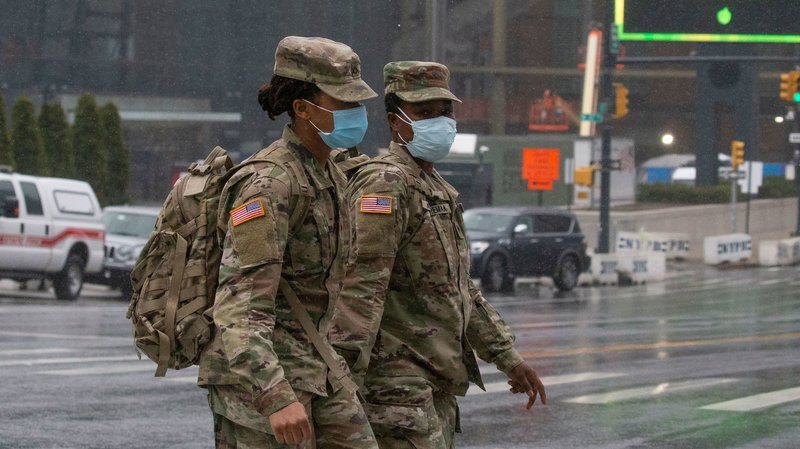
U.S. military personnel, seen outside the overflow hospital at the Javits Convention Center in Manhattan last month. The Pentagon has issued interim guidance advising caution pursuing recruits who have been hospitalized previously with COVID-19.
Nor is Eisenhower taken into account
The reality surpasses logic in the Trump administration. Making money continues to be the interest and not the care of people’s lives. That is why national security is being relieved, leaving aside a total battle against the enemy SARS-CoV-2 pandemic and continuing to bet on a war, or all the necessary ones, anywhere in the world against a supposed enemy that allows them to manufacture bombs and war equipment of all kinds.
When the numbers of infected and dead in the United States are terrifying -4,941,796 people infested, so probably this Sunday it will reach five million-, Congress has already discussed the Pentagon’s budget. We remember that independent Senator Bernie Sanders, published an opinion in The Guardian, in which he presented a true picture, a warning and a call:
“At this unprecedented moment in America’s history–a terrible pandemic, an economic crisis, people marching across the country to end systemic racism and police brutality, growing inequality of income and wealth, and an unstable president in the White House–now is the time to bring people together to fundamentally alter our national priorities and rethink the very fabric of American society.
The fact is that they approved $740 billion in spending and ignored Sanders’ proposal to cut 10 percent and target it to meet the needs of the most disadvantaged in the U.S. population, which would have been $74 billion for housing, education and health care, essentially. And the Vermont senator cited a Republican hero, General Dwight Eisenhower, who said in 1953 “Every gun that is made, every warship launched, every rocket fired means, in the final sense, a theft from those who are hungry and are not fed, those who are cold and are not clothed. This world in arms is not spending money alone. It is spending the sweat of its workers, the genius of its scientists, the hopes of its children.
The current situation is much more critical: a quarter of the U.S. population is living from paycheck to paycheck, and now from the pandemic subsidy check, which in July has not yet been approved by Congress; between 22 and 40 million fear eviction for not being able to pay the rent, 40 million also live in poverty, and 87 million lack adequate health insurance.
Sanders is not the only one busy with waste. California Democratic Representative Ro Khanna is proposing that money for the “modernization” of intercontinental ballistic missiles go to research on the anti-Covid vaccine. California Democratic Congresswoman Barbara Lee is calling for a $350 billion cut in the war budget.
Even Eisenhower could not change the military-industrial complex of which he warned, and even less do Sanders, Khanna and Lee, although they appeal to the emergency caused by the new coronavirus, when the President of the country, Donald Trump, daily minimizes the magnitude and lethality of the pandemic and only takes advantage of it to lead the situation in order to be re-elected next November.
Among his most recent manipulative expressions are assuring that children “are practically immune” to COVID-19, and almost assuring that they will have a life-saving vaccine by November 3 – election day – because he is pushing it with all his might, even though he says it is not to win at the polls, he wants to save lives?
Trump, who has long sought exclusivity on potential vaccines, announced in May that the huge task of delivering the vaccine will be in the hands of the military in conjunction with the CDC. At the time he said it would be at the end of the year, but the circumstances surrounding the election campaign, which are not in his favor, have led him to make the hasty declaration that in November he has the salvation of the world in his hands?
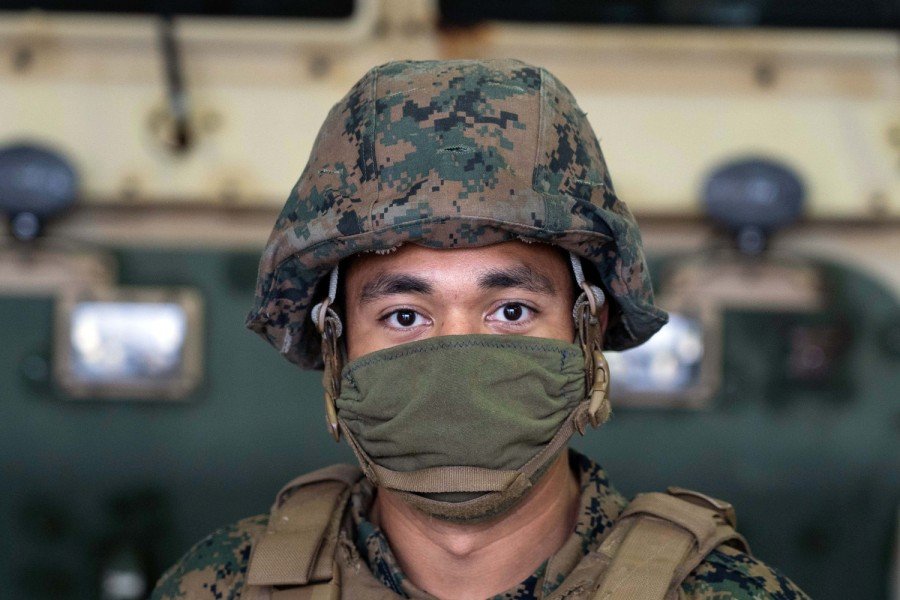
The military and COVID-19
There is a reality, in these dramatic times and when the number one enemy should be the pandemic. The Department of Defense is not accountable for its expenditures, while its contractors are making huge profits, as always, under the cover of a circumstance long highlighted by critics of the system. The main recipients of war industries’ contributions to their respective election campaigns are the members of the House and Senate Armed Services Committees.
To make matters worse, the new coronavirus has served to compensate arms manufacturers for alleged losses in profits as well. For example, General Electric, which has laid off 25 percent of its workforce, received $20 million to expand its development of “advanced manufacturing techniques,” and Spirit Aerosystems received $80 million to expand its domestic manufacturing after laying off 900 workers.
Some analysts warn that military expenditures could be reduced if the billions spent on the new Cold War with China were not available; if the Pentagon’s requests to buy the controversial and clearly imperfect F-35 fighter planes from Lockheed Martin were not met; or on Trump’s new warrior invention, the Space Force.
Included in the waste is General Dynamics Electric Boat’s $126 billion nuclear submarine program, the new Ford class aircraft carrier built by Huntington Ingalls for $13.2 billion, and its launch system that remains unlaunched but earns a profit for General Atomics. By the way, Bloomberg reported that the ship’s toilets are frequently clogged and can only be cleaned with specialized acids that cost about $400,000 per flush…).
The clogging is greater in those Pentagon priorities, when it becomes known from a June article in Tom Distpach, that in February 2018, the Government Accountability Office, which to some extent oversees federal spending, warned that the Defense Department’s health care system lacked the capacity to handle routine needs, let alone wartime emergencies, and within the ever-increasing military budget, military health care has grown next to nothing.
The 41,361 individuals linked to the Department of Defense, both military and civilian employees, infected with COVID-19, and in a staff mostly in the 18-24 age range we have not found the recognized number of deaths, will they be the humane and disposable part of that budget “oversight”?
Viola Davis Regrets Acting in THE HELP

Viola Davis Once Again Regrets Performing in THE HELP
July 15, 2020
Translated and edited by Walter Lippmann for CubaNews.
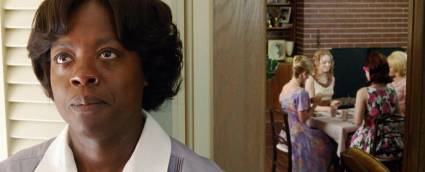
Viola Davis plays Aibileen Clark in the 2011 Maids and Ladies Firm. Autor: Frame of the film Published: 07/15/2020 | 02:50 p
This is not the first time that Viola Davis has publicly rejected her role as Aibileen Clark in the drama THE HELP, which this time she has described, in an interview with Vanity Fair magazine, as a film that maintains “the narrative of the white savior” and that did not give enough prominence to the black maids, reports the DPA agency.
The actress, who was nominated for an Oscar for best lead actor for her appearance in that film in 2012, has once again shown her regret, now within the context of the Black Lives Matter movement. Already in 2018, Davis showed h displeasure with the film directed by Tate Taylor in 2011.
“There’s no one who hasn’t enjoyed THE HELP, but there’s a part of me that feels I betrayed myself and my people,” Davis explains in an interview for the magazine she’s the cover of. “I was in a movie that wasn’t programmed [to tell the whole truth],” she adds, denouncing that the film is made “with the filter and the sewers of systematic racism.
Davis also denounces the lack of Black voices in the creative process in Hollywood. “There are not a lot of narratives that are involved in our humanity [referring to the African-American community],” she explains. She adds that the writers, directors and producers “try to delve into the idea of what it means to be Black, but thinking essentially about a white audience.
She added that in Hollywood “there are not enough opportunities for an unknown Black actress” to “get ahead” in the industry. In this way, Davis, who had already been nominated for an Oscar before THE HELP for her role in THE DOUBT, justifies her participation in the film that also starred Emma Stone, Jessica Chastain, Bryce Dallas Howard and Octavia Spencer, who won the Oscar for this film. “I was that actress who was trying to get into [the industry],” she says.
Not only Viola
Just a few weeks ago, Bryce Dallas Howard also disowned the film and recommended that the public not see THE HELP as a reference for fighting racism. The singer also added that she “would not” have participated in the film if it had been shot today.
It was in an interview with the Los Angeles Times that the Jurassic World actress spoke about the need to give voice to Black creators and for them to be the ones to address the African-American reality.
“I wouldn’t appear in the film again [if it had been made today]. I’ll tell you why: I’ve realized that now people have the courage to say, ‘With all due respect, I love this project, but I don’t think you should be the one to direct it. That’s a very powerful thing, to be able to say it,” the actress explained.
“In this transformation that’s happening, a new freedom of expression is emerging,” Howard added, emphasizing the importance of black voices in the industry, referring to the Black Lives Matter movement.
Trump takes his politics to Tulsa

Trump went with his politics to Tulsa, scene of the worst massacre of African Americans in recent U.S. history.
By Natalia Plazas
June 20, 2020
Translated and edited by Walter Lippmann for CubaNews.
In 1921 Tulsa, the city Donald Trump chose to resume his campaign for the presidency, was the scene of one of the most atrocious massacres in U.S. history against the Black community. Nearly a hundred years after the event, the facts remain virtually unknown to society.
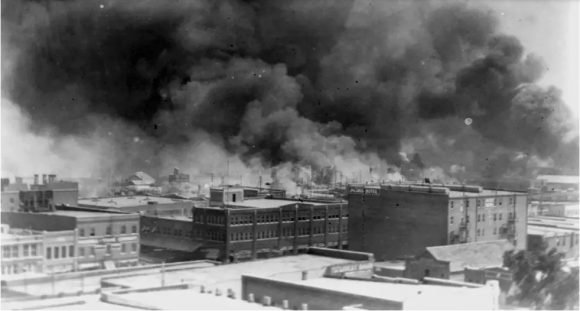
Smoke rises from buildings during the 1921 Tulsa, Oklahoma, USA massacre. Photo: Reuters
Donald Trump hit the nail on the head when he decided to resume his campaign for reelection in Tulsa, Oklahoma. Tens of thousands of his supporters await him there, but there is also a growing call for remembrance and justice from activist groups who remember that that city has not healed the wounds of the worst massacre in the country’s recent history against the African-American community.
On the night of May 31 to June 1, 1921, an entire neighborhood was razed to the ground and 300 black citizens were killed. The massacre began when a white crowd came to lynch a black man accused of sexually assaulting a white woman. That, supposedly, was the trigger for the tragedy, but history has revealed a much more perverse situation.
In the 1920s, the Greenwood neighborhood, a black enclave in the city of Tulsa, was noted for its economic prosperity. The distribution of land after the end of the American Civil War had benefited some African-American and Native American communities, and as a result Greenwood had become stronger, despite being segregated, like any black neighborhood at the time.
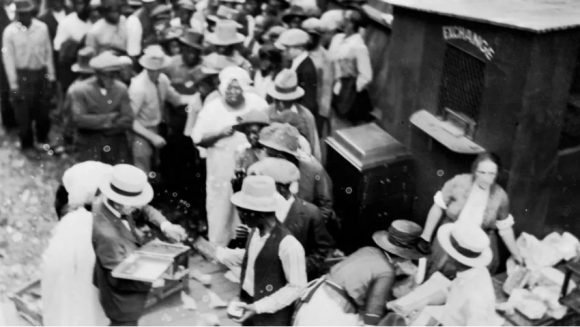
Archive image. A crowd of mostly African Americans lines up at the Exchange booth in Tulsa, Oklahoma, in 1921. © Reuters
From ‘Black Wall Street’ to a neighborhood in the ashes
Such was the commercial and economic success forged in Greenwood that it was commonly called the ‘Black Wall Street’, but soon its good fortune would bring it ruin. Members of the white community began to view their neighbors’ bonanza with suspicion and, interested in occupying their land during the railroad expansion, decided to attack the neighborhood.
On the night of May 31, a crowd of white men, supported by local authorities and even police, arrived in Greenwood and charged at the African-American population and their homes. The mob burned down homes and businesses to the point that when the situation calmed down hours later, at least 35 whole blocks had been left in rubble.
The blow took away the good fortune of the neighborhood forever. In the wake of the event, Greenwood’s recovery has been frustrated by the creation of laws promoting zoning or by building restrictions. Today in Tulsa, the social gap between blacks and whites is notorious. According to a Human Rights Watch report, poverty is almost three times higher among black citizens than among white citizens.
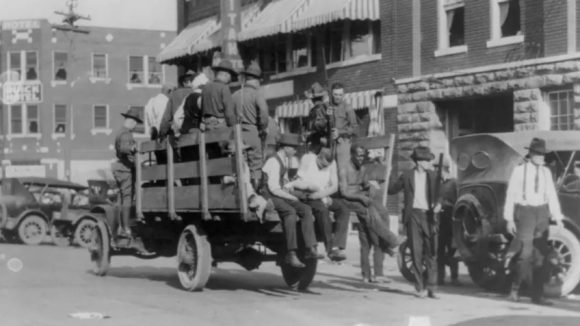
Archive image. A truck carrying soldiers and African Americans near the Litan Hotel during the 1921 Tulsa, Oklahoma race massacre. © Reuters
A Donald Trump rally ignites misgivings in a remote society
With Trump’s visit, originally scheduled to coincide with the celebration of Black Independence Day on June 19 [Juneteenth] and postponed amidst national protests against racism, the call for historical recognition of the victims and economic reparations for their descendants has intensified more than ever.
Less than a year before the 100th anniversary of the Tulsa incident, justice has yet to be established, despite the fact that the case has even been brought before the U.S. Supreme Court. Both lower courts and the high court have dismissed the claims. Currently, only two survivors of the massacre are still alive.
But Trump’s arrival has not only put the spotlight on a forgotten chapter of American history. His desperate attempt to revive in Oklahoma an image that has deteriorated in recent months due to the economic impact of the pandemic has highlighted the differences between his supporters and those who demand changes in the treatment of the African-American community.
“Any protester, anarchist, agitator, looter, or small-time person who goes to Oklahoma, please understand that they will not be treated as they have been in New York, Seattle, or Minneapolis. It will be a very different scene,” the president said before embarking on the trip to Tulsa.
The comment, which his critics call conflictive and divisive, comes at a time when the rejection of racial violence in the United States shows its greatest increase in decades, with weeks of massive demonstrations in multiple cities around the country that have also reached the doors of the White House.
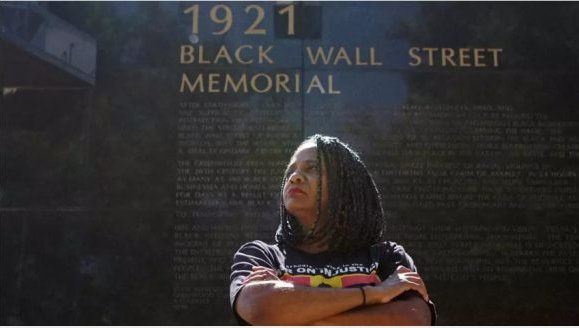
Tulsa Councilwoman Vanessa Hall-Harper poses for a portrait in front of a memorial to the 1921 Greenwood massacre. Tulsa, Oklahoma, USA, June 18, 2020. Lawrence Bryant / Reuters
Subscribe to Blog via Email
| M | T | W | T | F | S | S |
|---|---|---|---|---|---|---|
| 1 | 2 | 3 | 4 | 5 | 6 | 7 |
| 8 | 9 | 10 | 11 | 12 | 13 | 14 |
| 15 | 16 | 17 | 18 | 19 | 20 | 21 |
| 22 | 23 | 24 | 25 | 26 | 27 | 28 |
| 29 | 30 | |||||


You must be logged in to post a comment.